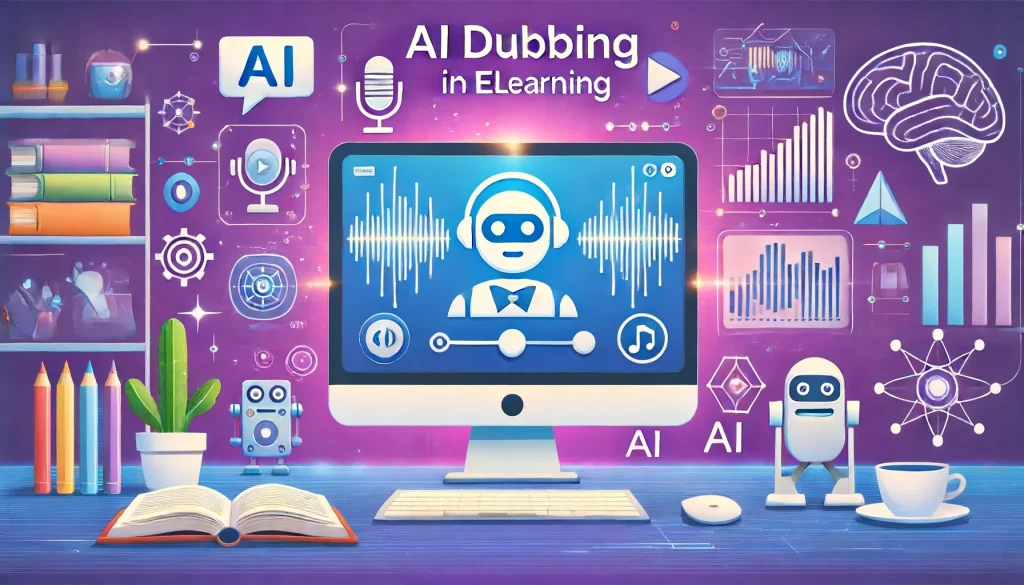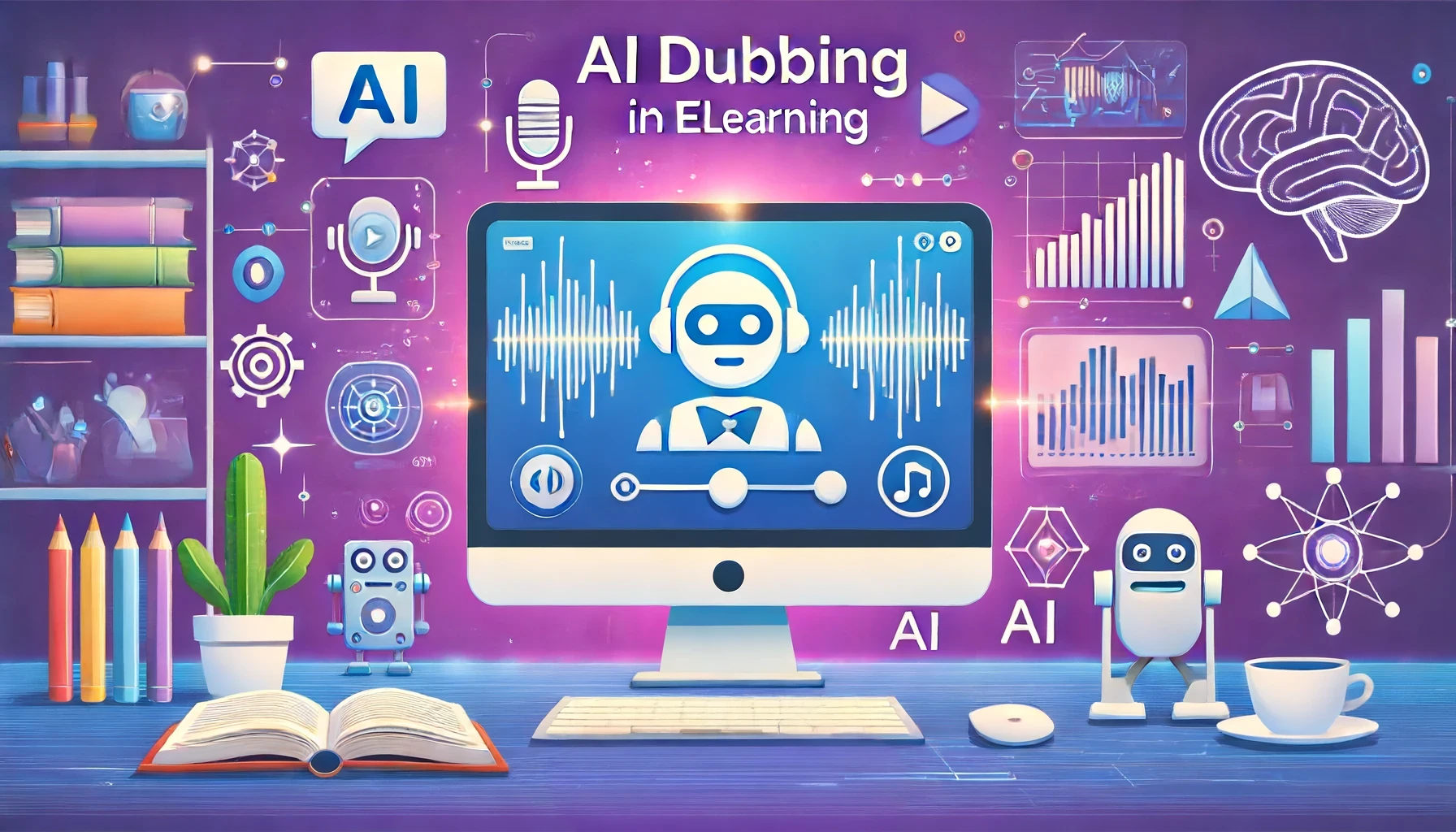AI dubbing involves using artificial intelligence to generate human-like voiceovers for video content. Unlike traditional dubbing, which requires human voice actors, AI dubbing leverages advanced algorithms, machine learning, and natural language processing to create realistic and contextually accurate voiceovers. This technology can be particularly useful in eLearning, where clear and engaging narration is crucial for effective content delivery.
Benefits of AI Dubbing in E-Learning
1. Enhanced Accessibility
One of the most significant advantages of AI dubbing in eLearning is its potential to improve accessibility. Traditional voiceovers can create barriers for learners with disabilities, such as those with hearing impairments or visual disabilities. AI dubbing can generate text-to-speech capabilities that can be adjusted to meet the needs of these learners. For example, screen readers can convert text into spoken words, while closed captioning can provide visual text for spoken content.
Example: An online course for visually impaired learners can use AI dubbing to convert written content into spoken words, making it easier for learners to access and understand the material. Similarly, AI-generated closed captions can help hearing-impaired learners follow along with video content.
2. Cost-Effectiveness
AI dubbing can significantly reduce the costs associated with producing high-quality voiceovers. Traditional dubbing requires hiring professional voice actors, booking recording studios, and scheduling recording sessions, which can be expensive and time-consuming. AI dubbing eliminates these expenses by automating the voiceover process.
Example: A company creating an extensive series of online training modules can use AI dubbing to produce consistent and professional voiceovers for each module without the need for multiple recording sessions. This not only saves money but also speeds up the production process.
3. Consistency and Flexibility
Consistency in voiceovers is essential for maintaining a cohesive learning experience. Human voice actors may vary in tone, pronunciation, and delivery, leading to inconsistencies. AI dubbing ensures a consistent audio experience across all content. Additionally, AI dubbing offers flexibility in terms of voice selection, allowing eLearning platforms to choose from a wide range of voices, accents, genders, and age groups.
Example: An eLearning platform offering language courses can use AI dubbing to provide native speaker voiceovers for different languages. Learners can choose their preferred accent or dialect, enhancing the personalization and effectiveness of the learning experience.
4. Multilingual Capabilities
In today’s globalized world, eLearning platforms often cater to diverse audiences with varying linguistic backgrounds. AI dubbing can facilitate the creation of multilingual content by generating voiceovers in multiple languages quickly and efficiently.
Example: A multinational corporation can use AI dubbing to create training videos in multiple languages for its employees around the world. This ensures that all employees receive the same information, regardless of their native language, promoting inclusivity and understanding.
5. Increased Engagement
Engaging learners is critical for effective eLearning. AI dubbing can enhance engagement by providing clear, professional, and relatable narration. The human-like voices generated by AI can convey emotions, intonations, and emphasis, making the content more captivating.
Example: An educational video series for children can use AI dubbing to create engaging and expressive narrations that capture the attention of young learners, making the learning experience more enjoyable and effective.
Challenges of AI Dubbing in E-Learning
1. Emotional Depth and Nuance
One of the primary challenges of AI dubbing is capturing the emotional depth and nuance of human speech. While AI-generated voices can mimic human intonations and expressions to some extent, they may still lack the subtle inflections and emotional cues that a human voice actor can deliver.
Example: In a drama-based eLearning module designed to teach conflict resolution skills, the emotional depth of the scenarios may be critical for learners to fully grasp the content. AI dubbing might struggle to convey the complex emotions needed to make these scenarios impactful.
2. Creativity and Adaptability
Human voice actors bring creativity and adaptability to their performances, which can be challenging for AI to replicate. Voice actors can improvise, adapt their delivery based on context, and respond to real-time feedback, adding a layer of creativity and authenticity to the narration.
Example: An eLearning course on creative writing might require a narrator who can bring stories to life with varying tones and styles. AI dubbing may find it challenging to adapt its delivery to match the creative nuances required for such content.
3. Data Privacy and Security
AI dubbing involves the collection and processing of significant amounts of voice data, raising concerns about data privacy and security. Ensuring that voice data is protected from unauthorized access and misuse is crucial for maintaining the trust of learners and institutions.
Example: An educational institution using AI dubbing must implement robust data security measures to protect students’ voice data and ensure compliance with privacy regulations.
4. Handling Complex Scenes
AI dubbing can struggle with complex scenes involving multiple speakers, rapid dialogue, or intricate emotional exchanges. Synchronizing AI-generated voices in such scenarios can be challenging, potentially affecting the realism and impact of the content.
Example: A case study video with multiple speakers discussing a business problem may require precise timing and interplay between voices. AI dubbing might find it challenging to achieve the necessary synchronization and emotional nuance.
5. Risk of Overuse and Monotony
Relying too heavily on AI dubbing can lead to a sense of monotony, especially if the same voices are used across different content. This can make the content feel formulaic and diminish the unique character that diverse human voices naturally provide.
Example: An eLearning platform that uses the same AI-generated voice for all its courses may risk creating a monotonous learning experience, reducing learner engagement over time.
Best Practices for Implementing AI Dubbing in E-Learning

To maximize the benefits and mitigate the challenges of AI dubbing, eLearning platforms should follow best practices:
1. Choose Appropriate Voices
Selecting voices that align with the content and audience is crucial. Consider factors such as age, gender, accent, and language proficiency to create a personalized and engaging learning experience.
2. Test for Clarity and Comprehension
Before finalizing AI-generated voiceovers, thoroughly test the audio for clarity and comprehension. Ensure that the narration is easy to understand, free from distortions, and effectively conveys the intended message.
3. Customize Pronunciation
Utilize pronunciation editors or tools to customize the pronunciation of specific words or phrases, especially when dealing with domain-specific terminology or regional accents. This customization ensures accuracy and authenticity.
4. Incorporate Expressive Elements
Take advantage of the expressive capabilities of AI-generated voices by adding appropriate intonations, emphasis, and emotions to the narration. This enhances the overall delivery and engagement of the content.
5. Provide Interactive Options
Enable learners to interact with the AI-generated voiceover by incorporating features such as pause, rewind, or skip. This interactivity promotes active learning and empowers learners to control their learning journey.
6. Consider Multilingual Needs
Ensure that the AI dubbing technology supports the desired languages and evaluate the quality of translations. Providing high-quality multilingual content promotes inclusivity and understanding.
7. Regularly Update and Improve
As AI technology advances, regularly update and improve the AI-generated voiceovers in your eLearning content. Stay informed about the latest developments and utilize them to enhance the learning experience continuously.
Future Prospects of AI Dubbing in E-Learning
The future of AI dubbing in eLearning is promising, with continuous advancements in AI algorithms, natural language processing, and voice synthesis. These developments will lead to even more realistic and human-like voices, enhancing the overall quality of eLearning content. Additionally, advancements in translation technologies will improve multilingual capabilities, enabling seamless localization of content.
As AI technology evolves, it will play an increasingly significant role in making learning more accessible, personalized, and effective. By embracing AI dubbing, eLearning platforms can create immersive and engaging learning experiences that empower learners to reach their full potential.
In conclusion, AI dubbing offers a range of benefits for eLearning, including enhanced accessibility, cost-effectiveness, consistency, flexibility, multilingual capabilities, and increased engagement. However, it also presents challenges such as capturing emotional depth, ensuring data privacy, handling complex scenes, and avoiding monotony. By following best practices and staying informed about technological advancements, eLearning platforms can leverage AI dubbing to create high-quality, inclusive, and effective learning experiences.
References
- Statista. (2023). “Projected growth of the global digital media market.” Retrieved from Statista.



